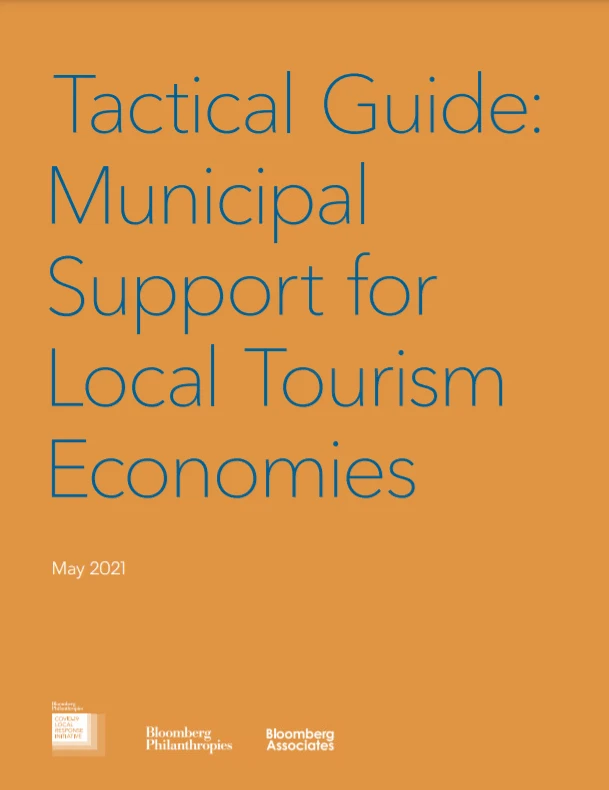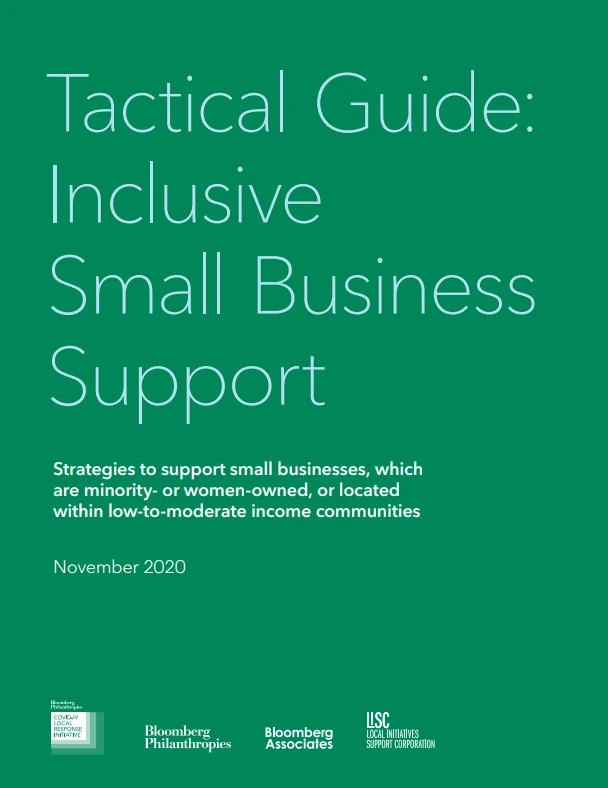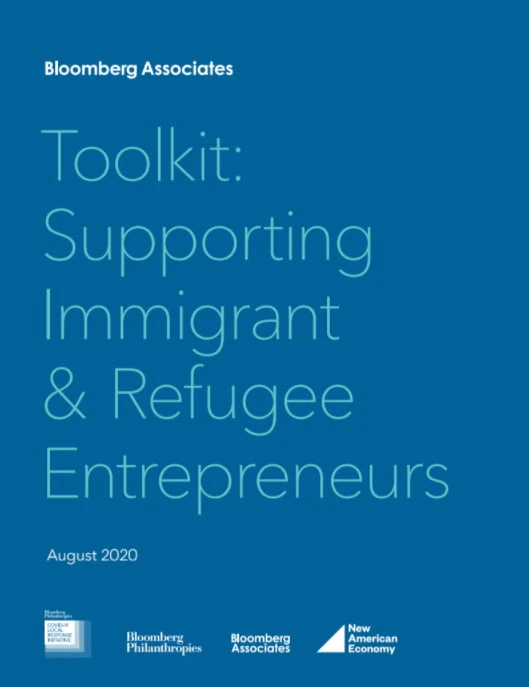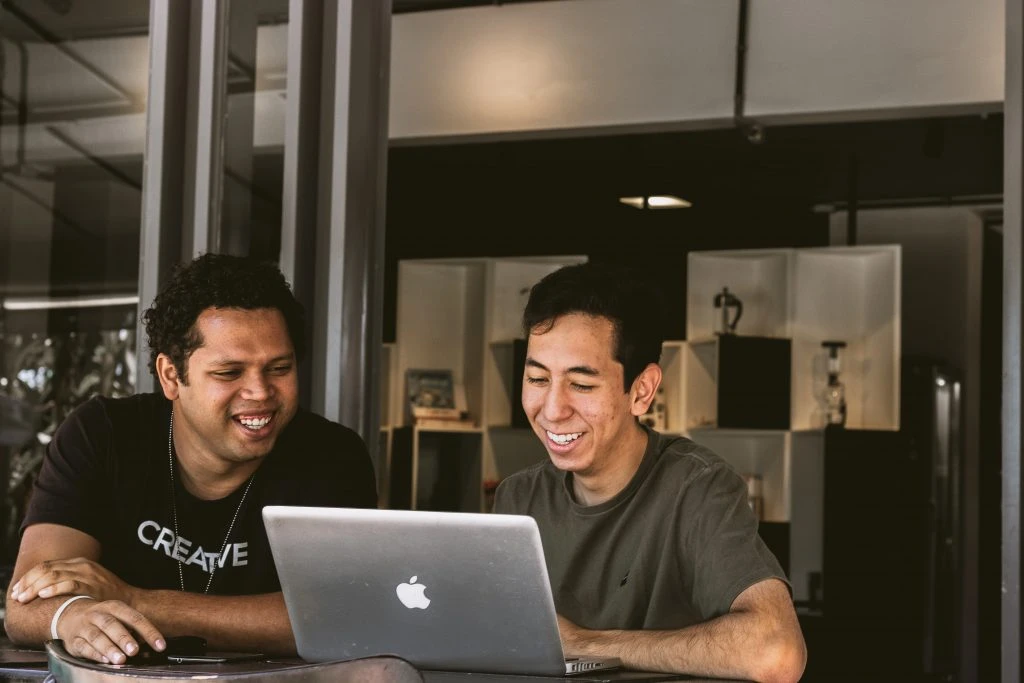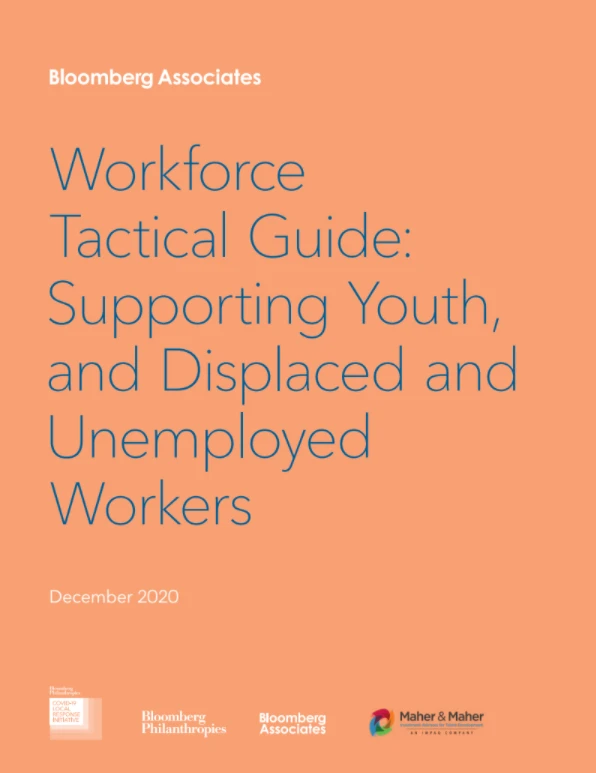COVID-19 Economic Response and Recovery
Help Your Industry to be at the Front of “The New Normal”
Action:
Convene thought leaders, analysts, entrepreneurs, and tech startups to focus on technology development and adoption that could reshape travel and tourism.
Why:
The pandemic is turning the travel industry upside down and has changed the way people think about travel. “The next incarnation of tourism is on its way.”
Background:
Thanks to the internet, the ways that people travel have changed drastically in a short span of time. Technology has made traveling safer and less time consuming, changed the way we book a flight or room, the way we are informed of events, or seek advice to sightsee a city. It has allowed us to have more personalized experiences, helped us to surpass language barriers, and even changed our packing routines. It is also impacting how destinations and those in the tourism industry market their products and services.
For example, data analytics, cloud computing and devices which are connected to the Internet-of-Things allow personalization for a better customer experience. Smart conversational interfaces have become more useful in providing feedback and answering customer questions. Free mobile connectivity not only allows travelers to share their experiences with others through social media easily, it also allows a destination to collect data about their travelers during different steps of the visit— which can help them sell the right product to the right visitor at the right time.
Case Study
Singapore Tourism Accelerator
Some cities are not only focusing on the immediate effects of the pandemic on the travel industry, they are also taking a longer-term perspective. For example, the Singapore Tourism Board has partnered with Ravel Innovation to create the Singapore Tourism Accelerator. It targets startups that are developing solutions to future-proof the travel and tourism industry and help tourism companies thrive amidst the challenges brought about by COVID-19. During the 4 month program, the selected startups develop pilot solutions to challenges which have been defined by local travel and hospitality businesses.
For example, convention and events businesses in Singapore are seeking a solution for the following challenge:
Current visitor, exhibitor, speaker and competition data collection/analysis is insufficient for customer insights and limits the ability to design personalized, hybrid experiences for the MICE sector. The company will design an online-to-offline (O2O) visitor management solution that can capture exhibitors and visitors’ data (e.g., interactions, transactions), analyze and profile visitors to help design better experiences and business matchmaking.
The chosen startup will gain unparalleled access to the leading industry players, and can also get assistance with temporary relocation to Singapore.

How To Adopt This Approach:
Identify an experienced tech accelerator partner and decide the size and cadence
of your cohorts (the Singapore Tourism Accelerator runs two rounds a year, each
with up to 12 companies).
Create an application process with clear selection criteria for admission to the accelerator. Promote the program extensively, through government colleagues, tech membership groups, incubators, universities, social media, conferences, and in person.
Design an accelerator program. The Singapore Tourism Accelerator consists of two phases:,a 2-week “acceleration” bootcamp, and a 3-month “pilot” phase. The bootcamp comprises modules, workshops, mentoring sessions, and events to help program participants define value propositions and use-cases, in collaborations with matched industry partners. During the pilot phase, participants work with industry partners to build prototypes and assess the feasibility of scaling up their solutions. The prototypes are funded by industry partner grants.
Finally, plan a demo day for participants to showcase their solutions to a wide set of industry partners and investors.

Do:
- Do recognize that many governments and DMOs are siloed, risk-averse, and bureaucratic organizations, and will find it very hard to digitally transform. Therefore, partner with brands and technology vendors which are better placed to develop solutions.
- Do seek innovative business and revenue models, where each party contributes something and each party benefits. Governments and DMOs should not underestimate the value of their authority, bully pulpit, data, audience reach and engagement, relationships, and ability
to “get things done” in the city.
Don’t:
- Don’t try to turn a DMO into a tech development company, as this is not your core strength.
- Don’t undervalue your assets and don’t simply hand over your data. Try to price what it would cost the vendor/partner to purchase these assets or achieve the same benefits on the open market.
Learn more about the Tactical Guide
Action:
Invest in financial coaching programs designed specifically for small businesses with a particular focus on serving minority, female and LMI entrepreneurs.
Why:
Businesses need financial coaching to secure grants and affordable loans and to keep their businesses and their personal lives financially healthy. By adding financial coaching to other business support services, Cities are improving outcomes.
Case Study #1
LISC + Ally Financial Coaching Program – Detroit, MI and Jacksonville, FL
In October of 2019, LISC and Ally Financial launched a $3 million program to provide financial coaching services to micro-entrepreneurs and aspiring homeowners. The micro-entrepreneurship program supports 500 minority and LMI microenterprises in Detroit, MI and Jacksonville, FL.
The program expands on LISC’s Financial Opportunity Center network, which includes more than 100 centers in cities across the US. These centers are operated by community-based organizations and help individuals find jobs, build credit, and improve overall financial health.
This program provides funding to hire financial coaches specializing in coaching microenterprises and entrepreneurs through the LISC Financial Opportunity Centers or micro-enterprise development community organizations.
The coaches integrate financial education into existing small business programming (e.g., business planning, accessing capital, marketing, etc.).
They offer one-on-one assistance for entrepreneurs as they navigate their personal and business finances, which are linked for many new entrepreneurs.
The coaching offered in each center is tailored to the needs of each community. In Detroit the program focuses on very early stage entrepreneurs and businesses. In Jacksonville, the coaching serves microenterprises that have been operating for some time with a few employees, but need assistance with their financial goals and planning to scale.
LISC estimates that it will support over 500 entrepreneurs across the two target cities, and anticipates that more than 50 percent will be women of color.
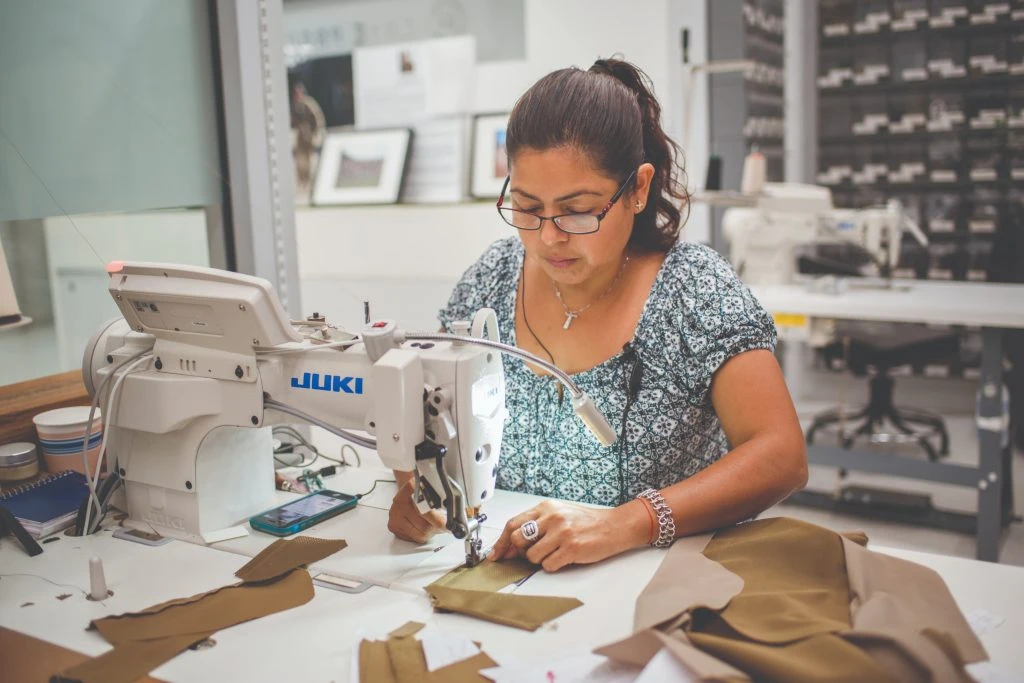
Case Study #2
Financial Empowerment Center – Nashville, TN
The Nashville Financial Empowerment Center (FEC) operates under a simple premise: that an “increase in the economic well-being of any Nashvillian improves the overall economic climate of the whole city.”
Founded in 2013, the Nashville FEC is a free one-on-one counseling program for all residents in Nashville. It is run by the United Way and funded by a $250,000 annual City grant.
Counselors help with a variety of personal finance issues, such as how to negotiate debt, navigating loan options, and general financial literacy.
Since 2013, the FEC has helped 7,700 clients reduce their debt by $14.2 million and increase their savings by $2.9 million. It has made a concerted effort to serve low-income residents and people of color, with 54% of FEC clients identifying as African American/ Black and 21% identifying as Latinx.

How to Adapt This Approach:
- Work with partners (e.g., local/ethnic chambers, technical assistance providers, merchant groups) to assess the financial education needs of local businesses, particularly MWBEs. Conduct a survey, hold focus groups and interviews with entrepreneurs to identify gaps and existing resources
- Build a coalition of partners (e.g., education institutions, technical assistance providers, CDFIs, local/ethnic chambers etc.) that are trusted and located in target neighborhoods and have experience offering business support services to local entrepreneurs. Utilize these individuals to help design curriculum for small business financial coaching
- Work with the coalition to develop a proposal for expanding financial coaching. The proposal should include the goal, the need/opportunity, the coalition of partners, the program design, location, staffing, budget, metrics, timeline/next steps
- Determine where the program will be housed, which will depend on the lead partners involved. Cities may want to house the program at the City or have a nonprofit take the lead and the City provide funding and support
- Use the proposal to raise funds to launch the program. Pitch local banks, philanthropic partners, and corporations (especially those serving low-income and communities of color) on contributing financially, providing in-kind support or advising the program. Partners will also be necessary to help train counselors, promote the service, etc.
- Hire staff. Number of FTEs depends on how many locations financial coaching for entrepreneurs will be offered, or if the whole program will operate out of one location. If partnering with multiple community organizations, there should be at least 1 FTE per location. If housing in one primary location, consider hiring 2-3 FTEs and scaling as needed. Ensure staffing is representative of the community being served
– Staff must be trained professionals with experience in financial coaching for small businesses and entrepreneurs. Make sure to have clear training standards for counselors
– Offer 1-1 appointments and have call/email options. A group class is much less effective, as people are hesitant to discuss personal financial circumstances in this format - Launch program with active outreach and media campaigns. Leverage partners in the community to reach business owners (e.g., merchant associations, local/ethnic chambers, community groups, etc.). Ensure that banks and financial institutions provide information about the service
- Track and publish KPIs on a regular basis. Include aggregated demographic and neighborhood data on entrepreneurs being served, services provided, outcomes, etc. (See KPIs section)
Learn more about the Tactical Guide
COVID-19 Economic Response and Recovery
Drive Anchor Procurement to Local Businesses
Action:
Seek a commitment from local universities and hospitals (“eds and meds”) to procure more goods and services from local, target, small businesses; and help them to identify and engage qualified firms. Tie the program to a small business capacity-building technical assistance program.
Why:
In this way, you will support local businesses through the recession, grow your local supply chain’s capacity, and keep more money local.
Case Study
DC Community Anchor Partnership – Washington, D.C.
Despite 47% of businesses in the District of Columbia being owned by entrepreneurs of color, MBEs only receive 3% of the region’s $205bn private-sector economy.
The DC Community Anchor Partnership was created by the Coalition for Nonprofit Housing and Economic Development (CNHED), a Washington DC nonprofit. CNHED worked closely with the Office of the Deputy Mayor for Planning and Economic Development.
The Partnership comprises:
- 4 anchor members (1x university and 3x hospitals)
- 3 community partners (1x municipal department’s technical assistance center, 1x Latino development center, and 1x community investment fund) and
- 6 founders (1x government, 1x nonprofit and 4x corporates).
It is staffed by 2 FTEs and has three main functions:
- Connecting anchor institutions to share best practices
- Analyzing the procurement needs of each anchor institution
- Identifying which goods and services currently being outsourced to regional or national suppliers, could be replaced by local MBEs.
The Partnership’s staff include former corporate procurement officers, who analyze the anchor’s procurement practices, encourage them to change practices, and match them with local MBEs. Their engagements are focused on the anchors’ executives, government affairs, and procurement offices. They create individual action plans, with specific goals and timelines, for each anchor.
The Partnership’s staff have also created a database of approximately 5,500 local MBEs, which they use to identify, screen and match against anchor procurement opportunities. They also connect the MBEs with technical assistance to get them ready to compete for contracts and successfully deliver them. Where a contract is too large for any one local MBE, the staff work with the anchor to split the bid between two or more providers.
In response to COVID-19, the partnership shared with its anchors a pre-vetted list of goods and services offered by MBEs, including masks, gowns, gloves, and cleaning and catering services.
In 2017, the 4 anchors procured $5.1 million from local MBEs with the help of the Partnership. Through DCAP, that number had grown to $15.3 million in 2019.

How to Adapt This Approach:
- Identify a strong, local nonprofit with a mission to support MWBEs, or galvanize the creation of a consortium
- Allocate dedicated nonprofit and City staff and/or seed funding
- Identify, convene local universities, colleges, hospitals, and other anchor institutions with significant, permanent locations in the city
- Prepare persuasive messaging and data about both the problem and the difference that the institutions could make
- With the support of your Mayor, reach out to at least 3 leaders from these institutions (CEO, finance officer, and government affairs officer). Make sure the leaders are aligned on a common agenda and understand any barriers to the institutions working together
- Convene the institutions’ leaders, encourage them to make commitments to procure local, and to instruct their organizations to cooperate. Encourage them to make these commitments public in due course
- Consider possible incentives, including around land development, and/or tax breaks.
- Go out and pitch for corporate and philanthropic funding, which can be used to recruit staff, purchase data, run events, provide TA, etc.
- Conduct an assessment of each anchor institution’s procurement practices. Develop an individualized action plan and procurement goals with timelines for each institution. Encourage anchors to publish a rolling forward plan of their procurement needs
- Work with local/ethnic chambers, business organizations, and private sector data companies to identify and develop a list of MWBE providers. It is critical that this list is verified and that providers are vetted before being forwarded to anchors. In particular, create a repository of vetted MWBEs through requests for information and market surveys, which evaluate providers’:
– Products and Services: price, quality, industry experience
– Management Capacity: RFP development and response, account support
– Operational Efficiency: staffing, accounting, technology
– Financial Capacity: revenue growth, bonding
– External Presence: online presence, community impact, references - Refer MWBEs, which are found not to be competitive to business support organizations and technical assistance so they can become competitive in the future
- Establish a data-tracking system to capture key metrics to measure success of the program
Learn more about the Tactical Guide
COVID-19 Economic Response and Recovery
Cross-Sector coordination: creating a task force, committee or network to support new Americans
Short-term planning: ensuring an inclusive recovery
For cities that have not already convened a multi-sector set of partners to identify and address the needs of immigrant and refugee communities as part of their overall COVID-19 response and recovery planning, the first step should be to bring the right set of partners to the table.
This effort should be:
- Multi-sector: This group must include representation from local government, as well as organizations that serve immigrants and refugees, such as refugee resettlement organizations, local Offices of Immigrant Affairs, and other community-based organizations; and may also include chambers of commerce; universities; private corporations, community foundations, and financial institutions; and faith-based organizations.
- Data-driven: Cities should make use of existing metro-level research on immigrants and refugees (e.g., New American Economy’s Map the Impact which provides metro-level economic and demographic data about immigration), as well as local surveys of immigrant and refugee business owners. Cities should collect data on country of origin and/or language requests as part of service delivery (e.g., through small business relief funds), taking care to not include questions about immigration status or keeping such information confidential, if it is necessary to collect.
- Empowered to make and implement recommendations: Recommendations made by this group should be advanced as part of the city’s overall response, adaptation and recovery effort, including policy change and the development of new targeted programming.
- Locally and/or privately funded: Due to federal funding restrictions, immigrants — especially undocumented immigrants — may be left out of COVID-19 relief funds and other forms of federal aid, assistance or benefits. Unrestricted local public dollars or private funding should be tapped to ensure that all small business owners, regardless of immigration status, are able to access the necessary support and resources.
Long-term planning: promoting inclusion through systems change
This same Task Force or Committee structure should also be tasked with developing a longer-term, multi-year inclusion plan — if such a plan is not already in place. Cities with strong immigrant inclusion plans typically follow a 6-month to 1-year timeline that includes the following core elements.
1. Partner with a university or research institution to gather data on immigrant and refugee entrepreneurship. Research studies have catalyzed efforts to support immigrant and refugee businesses by providing greater knowledge of the existing community, helping to identify the types of businesses and sectors in which immigrant entrepreneurs are concentrated, uncovering common challenges and concerns, and providing high-level talking points on the positive economic impact.
- St. Louis, MO: A pair of studies conducted by a St. Louis University economist highlighted the economic impact of immigration on St. Louis and identified immigrant-driven strategies for promoting economic growth in the region, leading to the creation of the St. Louis Mosaic Project in 2012. Both studies were funded by the William T. Kemper Foundation.
- Houston, TX: A report produced by New American Economy found that 13.4% of Houston’s immigrant population were self-employed, outpacing the national average for immigrants (11.9%) and the U.S.-born (8.8%). The study also found that immigrants in Houston were 53.2% more likely to be entrepreneurs than their U.S.-born counterparts, and that they generate more than $3 billion in business income annually.
- New York, NY: A study conducted by the Association for Neighborhood and Housing Development, which included surveys and focus groups of immigrant business owners, found that 56% of immigrant business owners live in the neighborhood in which they operate their business, and that rent burden was the top concern across all neighborhoods surveyed.
2. Create a multi-sector steering committee or task force charged with developing recommendations to support foreign-born entrepreneurs. This group should include representatives from local government, chambers of commerce, universities, community-based organizations, financial institutions and other organizations. Entrepreneurship may be just one focus area among several — with the goal of facilitating immigrants’ economic, civic, and social integration.
- Chicago, IL: The Chicago New Americans Plan, spearheaded by the Chicago Office of New Americans in partnership with a 50-person multi-sector advisory committee, resulted in 27 recommendations, including 5 to support immigrant entrepreneurship. These included creating a small business incubator, a “Chamber University” to train chamber of commerce leaders to better support immigrant entrepreneurs, and efforts to promote tourism in immigrant neighborhoods.
- Salt Lake County, UT: The Salt Lake County Welcoming Plan — supported by New American Economy, Welcoming America, the Salt Lake Chamber and the Salt Lake County Mayor’s Office — resulted in three overarching goals and 11 strategies to support new Americans, including a recommendation to incorporate business centers serving immigrants and refugees into the mainstream Business Resource Center network.
3. Gather feedback directly from community members and entrepreneurs. Soliciting public comment, and creating opportunities for two-way dialogue between city leaders and the community, ensures that the recommended strategies are actually addressing the need. This also helps build public support and buy-in for the plan.
- Akron, OH: As part of a year-long planning process to develop a Strategic Welcome Plan, the City of Akron and Summit County hosted a public Welcome Summit — attended by more than 250 community leaders and residents — to gather direct feedback. Access to capital, business training, and the creation of a business incubator were identified as community priorities.
- Dayton, OH: The City of Dayton solicited public feedback on the Welcome Dayton Plan, which included the creation of an immigrant entrepreneur ambassador program to support a local immigrant commercial corridor.
4. Create a formal, long-term structure to advance the recommendations. To ensure implementation of recommended programs and policies, cities often establish long-term structures, such as a task force or Office of New Americans, staffed by local officials who work directly with community partners. This can include regular meetings, subcommittees focused on key issues such as entrepreneurship or economic development, and public-private partnerships to advance inclusion work.
- Atlanta, GA: Welcoming Atlanta, an initiative started out of a multi-sector strategic planning process, is part of the Atlanta Mayor’s Office of Immigrant Affairs, and works to advance programs and policies that improve quality of life for newcomers — including multilingual COVID-19 resources.
- Lincoln, NE: The Lincoln New Americans Task Force includes public and private organizations and community members who meet regularly to help promote policy change and programming that facilitates immigrant integration. The Task Force recently published its first-ever New Americans Task Force Immigrant and Refugee Survey Report, which included a focus on economic development and identified barriers to full participation.

Learn more about the Toolkit
Action:
Work with partners to create a loan or grant product focused on MWBEs and LMI small businesses.
Why:
By designing financial support programs with and for targeted communities, you can maximize the impact on high-need groups.
Case Study
African American Business Revolving Loan Fund & SF HELP – San Francisco, CA
In the summer of 2020, the San Francisco Office of Economic and Workforce Development launched two loan programs focused on MWBEs impacted by COVID-19: the San Francisco Hardship Emergency Loan Program (SF HELP) and the African American Revolving Loan Fund.
The African American Revolving Loan Fund was specifically designed to address the structural inequities facing Black-owned small businesses and microenterprises.
The $3.2M fund offers loans up to $50,000; 0% interest; up to 6 year term; no collateral; flexible repayment options as well as technical assistance.
While any business regardless of race can apply to the fund, the City intentionally named it the “African American” loan fund. Outreach and marketing focused on Black small business owners, and was done by trusted Black community partners, such as the San Francisco African American Chamber of Commerce.
The City used a scoring system, which prioritized businesses located in historically Black neighborhoods, the length of the tenure in the city, and businesses that culturally contribute to the African American community.
The program is funded entirely through philanthropic or partner support and is administered by Main Street Launch (a local CDFI) and is expected to help 80 small businesses.
The second program is SF HELP.
The $8.5 million fund supports small businesses in high-need neighborhoods, particularly those directly serving the public and/or employing lowerwage workers.
Loans are up to $50,000; 0% interest; up to 6 year term; no collateral; with payments deferred until January 2021. Businesses must have a 25% drop in revenue due to COVID-19 and have not received a PPP loan.
The City awarded over $3.5 million to 108 total small businesses (71% minority-owned, 51% womenowned); retained 443 jobs with 50% of funding going to business in LMI neighborhoods.
The program is funded through $3.5M from the City general fund, $1M in philanthropic support, and $4M in leveraged capital, and is administered by Main Street Launch and the Mission Economic Development Agency

How to Adapt This Approach:
- Assess the capital needs of small businesses in the community with a particular focus on which groups of small businesses and neighborhoods face the greatest challenges
- Identify which small businesses the fund will be designed for. Determine if the fund will focus on supporting all MWBEs; businesses located in LMI areas or some other criteria of need
- Identify and develop philanthropic and/or corporate partners to financially support the fund. Leverage City funds to draw in this outside match
- Work with a local CDFI, or other nonprofit partner, to administer the program and draw in their own sources of capital
- Create the program parameters (loans, grants, size, use, terms, eligibility criteria, etc) based on the City’s policy goals, input from program partners and local stakeholders. Examples of program parameters: SF HELP, SF African American Loan Fund, Atlanta Resurgence Fund, Houston Small Business Economic Relief Program, Portland Small Business Relief Fund, Silicon Valley Strong Small Business Grant.
- Incorporate technical assistance partners to provide business support
- Partner with merchant associations, local/ethnic chambers, and other community groups who are trusted partners in the communities where the fund is focused, to lead outreach, and promote the fund
- Leverage technical assistance partners to help targeted small businesses apply to the fund
- Maintain a reasonable (e.g. 3+ weeks, include pre-noticing, not first come first serve) window for application submission. Assemble an inclusive application review committee to make award decisions. Evaluation criteria could include:
- MWBEs
- Businesses that did not receive CAREs Act or other COVID-19 relief funding
- Businesses located in LMI communities
- Businesses with a plan to reopen or adapt to the post-COVID environment
- Length of time operating in the city
- Sector
- Add all applicants into a centralized business support database/client relationship management tool (CRM) to coordinate future support
- Provide wrap-around technical assistance to businesses who receive funds as well as those who do not
- Track and publish KPIs on a regular basis. Include aggregated demographic and neighborhood data on applications and awards. (See KPIs section)
- Keep partners, particularly neighborhood stakeholders and local business groups, updated on progress and any challenges
- Track lessons learned and incorporate into future programming
Learn more about the Tactical Guide
COVID-19 Economic Response and Recovery
Center employers and partners in data and program evaluation and realign efforts to ensure industry alignment with workforce efforts
Ways to Help Displaced and Unemployed Workers Re-enter the Labor Market
Background:
In order to respond to rapidly shifting and dynamic market adjustments, re-engaging business leaders, re-examining data, and identifying short-term and long-term action plans has become crucial to meeting both workforce supply and demand needs. Additionally, proactive efforts are being generated by industry themselves, and our efforts to help support these initiatives have required some flexibility in coordination and alignment.
The examples below represent city-led and workforce-aligned efforts to strengthen connection to education, training, and work-based learning opportunities; financial supports; and rapid reemployment that attempts to address the needs of particularly hard-hit communities with a focus on equity and the development of career pathways, as well as impacted industries.
Many local, regional and statewide efforts have sought to address the needs of businesses and workers through a variety of strategies considered promising practices that succeeded in the last economic downturn, aligned with more recent innovations. Most have leveraged existing sector strategy efforts and some have provided employment supports for virtual learning and virtual work initiatives, as well as the transition of workers to new career pathways based on transferrable skill sets.
Some local efforts have included new innovative twists to respond to the specifics of this COVIDrelated crisis, two of which we are highlighting for you.
Each example, to varying degrees, includes the following essential elements:
- Heavy reliance on real-time labor market information, partnership alignment, and employer engagement: All involve rapid assessment of data and realignment to new priorities and hit upon the key promising practice for all workforce efforts — they are industry-aligned or employer-led, and a broad swath of key trusted partners are engaged. There is a clear commitment to high-demand industries and occupations.
- Braiding traditional and more flexible funding sources: In each case there is a clear effort to align general funds, emergency grant funds and/or philanthropic funds to braid with traditional workforce development formula funding to ensure flexibility and responsiveness to immediate needs.
- Commitment to equity, as well as student and job seeker supports: These efforts have implemented new tools such as equity frameworks and rubrics in the recruitment and screening process, with a focus on transferrable skills between sectors, assistance to get back into the labor market in a temporary position and financial support to supplement temporary position income so that participants can also study part time to gain new skills. Each incorporates a heavy focus on worker and student wraparound supports such as case management, career navigation, and legal and mental health services.
Case Study
Baltimore Health Corps
Baltimore City Mayor’s Office of Employment Development- Baltimore, MD
Program Overview:
- Temporary employment for over 300 community members
- Focus on career pathways within health care
- Upskilling training available
- Support services for workers
In March of 2020, the Baltimore City Health Department, Baltimore City Mayor’s Office for Employment Development (MOED), Mayor’s Office of Performance and Innovation, Baltimore Corps, the Baltimore Civic Fund, HealthCare Access Maryland, Bloomberg Philanthropies’ Innovation Team (i-team), and Jhpiego, a Johns Hopkins University affiliate, partnered to address the dual need of responding to the public health crisis caused by the pandemic and rapid reskilling and reemployment of the available workforce.
The new initiative, the Baltimore Health Corps, focuses on contact tracing, a method of identifying people exposed to the novel coronavirus, with the intent of preventing and containing transmission.
Program Specifics Include:
- Training and employment of over 300 residents for immediately available contact tracing related positions, with a focus on helping residents get on long-term career paths.
- Majority of positions are contact tracers, but the project also employs a care coordination team of about 40, which connects residents to needed social services, as well as operations support staff, supervisors, directors, managers, and career navigators to support the temporary contact tracer positions.
- Positions pay from $35,000 and up to $80,000 for the highest-level positions, and each includes a stipend to cover health benefits. Most last for eight months.
The project team carefully crafted new rubrics for screening and rating candidates prior to opening the job portal in June. The purpose of the rubrics is to eliminate barriers and bias in the process, while increasing equity and access to disadvantaged populations. These include detailed directions for applicant pre-screening, resume review, group screening and breakout session rubrics, and a rubric for pre-recorded interviews.
Once resumes have been screened through the portal, those that receive middle scores in the rubric are invited to a group interview with behavioral questions, while those that are high-scoring receive a link to pre-record an introductory interview, which will later be reviewed by staff.
The emphasis of the selection criteria throughout the interview process is on customer service and the ability to display empathy, as well as any other transferrable skill sets. This process provides opportunity for those middle scores to still advance in the process, with some being referred to shortterm upskilling programs, rather than being immediately referred to other programs and services outside of the Baltimore Health Corps.
Once hired, individuals in contact tracer positions begin two weeks of in-person training, and then their work is conducted from a centralized office building location until they are comfortable and competent with the contact tracing platform, after which they may opt to work from home. New employees are provided with a laptop and cell phone.
The provision of equipment is an equity strategy to ensure that some of those most at risk in the pandemic have the tools they need to be employed. Positions also come with employee supports, provided through MOED, including career navigation, financial empowerment counseling, and free behavioral health and legal services.
For a select number of applicants (up to 100) who show potential but might not yet ready for the contact tracer positions, the initiative offers a four-week community health worker training to help strengthen their candidacy. Completers are recommended to employers for priority recruitment, which serves as yet another equity strategy for upskilling local residents.
Key Partnerships:
The Baltimore Health Corps initiative is driven by critical partnerships. Key partners and their roles include:
- Mayor’s Office of Employment Development is the primary workforce agency, providing planning and staff for the recruitment and screening structure, career navigation, and connection to behavioral health support and legal services (offered through with Catholic Charities and Maryland Volunteer Lawyers Services).
- The Baltimore Civic Fund serves as the fiscal sponsor and provides assistance with fundraising and funding consolidation that supports streamlined relationships between funders and the city.
- Baltimore Corps conducts recruitment, providing the application website and the recruitment structure.
- Mayor’s Office of Performance and Innovation provides strategic and project management support.
- Jhpiego provides operational support to the Health Department, along with acting as a training partner for contact tracers and providing structure for performance monitoring.
- The University of Maryland School of Public Health is evaluating the program and will conduct a process study and summative evaluation.
- They are working on final outcome measures and supporting the team by providing a summary of performance metrics.
- The Baltimore Innovation Team (i-team) is supported by Bloomberg Philanthropies which awards cities multi-year grants to create highly skilled in-house teams that are dedicated to solving big problems in new ways — from reducing violent crime to revitalizing neighborhoods to strengthening the growth of small businesses.
The full list of partners and funders for this project include:
- Abell Foundation
- Annie E. Casey Foundation
- Baltimore City Health Department
- Baltimore Community Foundation
- Baltimore Ravens
- Bank of America
- Jacob & Hilda Blaustein Foundation
- Bloomberg Philanthropies
- BGE
- CareFirst
- France-Merrick Foundation
- Goldseker Foundation
- BACH (Baltimore Alliance for Careers in Health)
- Baltimore City Health Department
- Baltimore Civic Fund
- Baltimore Corps
- Catholic Charities of Baltimore
- HealthCare Access Maryland
- Jhpiego
- Maryland Volunteer Lawyers Service
- Mayor’s Office of Employment Development
- Mayor’s Office of Performance and Innovation
- Univ. of Maryland School of Public Health
Funding:
The total cost of the initiative is $12.44 million. This public-private partnership was mobilized by a $3 million commitment from The Rockefeller Foundation through its Equity & Economic Opportunity and Health teams. The City of Baltimore has made a $4.5 million commitment to support this initiative, tapping into its CARES Act Funds.
Additional private funders and local institutions have contributed more than $3.6 million in support and include the Annie E. Casey Foundation, Bloomberg Philanthropies, CareFirst BlueCross BlueShield (CareFirst), the France-Merrick Foundation, the Goldseker Foundation, OSI — Baltimore, the PepsiCo Foundation, the Rauch Foundation, the Stulman Foundation, and the T. Rowe Price Foundation. The city will continue to raise the remaining $1.3 million as the project moves forward.
Key Challenges:
Rapid partnership building
MOED and the Health Department had not previously worked this closely before on a combined effort at this scale. The entire initiative was built on leveraging virtual tools such as Zoom and Webex, from remotely coordinating partnership alignment and communication to recruitment efforts.
Prior to the pandemic, the Health Department had not previously relied on the workforce system for hiring needs, and did report having struggled at various times with recruitment and identifying applicants who meet the needs of a specific position but had not aligned themselves with the workforce system.
Through this new program, the Health Department expressed their satisfaction with the candidates that have been onboarded and working for a few weeks now. Baltimore Corps’ work to identify candidates who would be successful in this environment has been pivotal to their success.
The Health Department would recommend to other similar departments that are uneasy at taking on this challenge that it really has been an incredible experience, they are very happy and pleased with the results thus far and are looking forward to continuing the relationship.
Communicating vision to existing program staff
Developing processes for a large recruitment and placement initiative while not greatly expanding staff numbers (FTEs) could have been daunting to existing staff. Leadership developed a clear plan for weekly recruitment process flow and spoke directly with team members about the importance of the mission and value to the community. As a result of sharing the broader community vision, they were able to engender a sense of shared ownership and buy-in from staff as they launched the program.
Aligning communication strategy
Aligning a large multi-partner communication plan can be challenging in the best of times. At the outset, the Public Information Officers for each organization came together to engage their preexisting Joint Information Center (JIC) and worked to align their communication efforts. It had existed prior to the project; and, it was effectively leveraged in a virtual environment to coordinate the rapid building of this effort.
The Health Department took a lead role, along with MOED and Jhpiego, to get the word out to partners, and to the public through public virtual town halls, and at all relevant events held throughout Baltimore City. Additionally, they employed the use of multiple social media outlets, such as Twitter, Facebook, and Instagram. Partners met weekly, and shared information frequently across major program components, and continue to check in regularly as needed.
Summary of Project Impact
The team has received 4,500 applications since the program launched on June 4, 2020. As of November 6, over 200 applicants have accepted offers to join the Health Corps, and nearly 175 have already started their temporary positions with HCAM and the Health Department. To serve these staff, the Mayor’s Office of Employment Development hired five career navigators and placed approximately 100 participants into community health worker (CHW) training through the Baltimore Alliance for Careers in Healthcare.
The program team has contracted with University of Maryland School of Public Health to act as external evaluators. They will track standard workforce metrics as required by their grants but are looking to move beyond the traditional measures. They are also evaluating the public health contracting side of the project, as well as care coordination. The team will also conduct a post-intervention analysis to determine if the Health Corps program led participants to long-term employment within a health care career pathway.
Adapt This Approach:
Cost and Time Commitments:
From initial award to program launch, this program took six weeks. The rapid pace was driven by high COVID-19 case volume in the late spring and summer and a recognition of immediate need. The time and resources required to implement this model will depend on a variety of factors including:
- Availability and flexibility of funding streams
- Flexibility of existing team to work overtime and adaptability to shifting priorities
- Existing relationships and coordination with partners
- Community support and outreach strategies

Do:
- Do borrow from other models and adapt to local context.
The team leveraged the Massachusetts Partners in Health model to develop their contact tracing hiring strategy to allow for an explicit focus on rapid re-employment of the unemployed. They could have focused on quickly hiring the highest level of education possible, but their local commitment to employing dislocated workers with an equity lens required different strategies. The team believes the Baltimore Model is a promising and adaptive approach for other cities looking to expand their contact tracing capacity while addressing their jurisdiction’s economic and social needs. - Do engage employers throughout the process.
Because of the focus on upskilling participants and putting them on the road to clear career pathways in health, the team made the employer partners a part of the entire process — from weekly meetings to keeping them informed of participants’ training status. They were, of course, a key partner to the initiative, but their full engagement helped to drive the success of the recruitment process, and, in this way, demonstrated the key benefits of employer alignment. The employers’ public health expertise informed the program design and ensured that participants will come out of the program with the skills needed to go into full-time employment within an industry career pathway. - Do begin with a diverse and connected project management team.
The core team at Baltimore City included workforce experts, epidemiologists, community health work practitioners, and managers across each of the program objectives. Through these diverse viewpoints and early, open dialogue about program aims, the team was able to align its workforce and public health aims towards creating the most effective program possible. The team began by developing a solid operational framework that leveraged existing partnership organizations to support rapid implementation. The larger core project team across partners included leaders from all of the aligned organizations, totaling between 45-55 members.
Don’t:
- Don’t rely solely on traditional funding strategies.
Alignment of private funds and CARES Act funds, with a small portion of dislocated worker funds, provided the program team the flexibility to move ahead with recruitment and hiring for positions quickly to respond to urgent demand. Flexible funds also allowed Baltimore to contract for legal and mental health service supports quickly, and to support CHW training. - Don’t rely on traditional hiring strategies.
The Health Department partnered with the workforce team to craft job postings with no education requirements, which opened the process to a wide swath of the community. They also expedited their hiring process by working closely with Baltimore Corps and Jhpiego, employing the use of their existing online platform for screening candidates, and by developing a clear rubric and comprehensive plan for interviewing, training, and hiring.
Case Study #2
Train for Jobs SA, San Antonio, TX
Program Overview:
- Training stipend of $15/hr
- Up to $450 per week
- Up to 10,000 residents by September 2021
- Anticipate 80% receiving wraparound support
In May 2020, Workforce Solutions Alamo (WSA), in partnership with the City of San Antonio and Bexar County, established Train for Jobs SA, a training program designed to quickly upskill dislocated individuals for high-growth industries and occupations.
In addition to free training, participants also receive weekly stipends and significant wraparound services to support successful completion of the program and then placement into a job. The program was made possible through the commitment of the City of San Antonio and Bexar County officials who prioritized workforce development as their leading strategy to guide the city into and through recovery from the pandemic.
The overall goal of the program is to provide economic stability for those who are displaced as well as ensure the talent needed to support local industry is available as businesses begin to recover. Train for Jobs SA aims to serve up to 10,000 San Antonio and Bexar County residents by September 2021.
Eligible participants enroll via phone, and once in the program, complete a skills and career assessment. Participants may then be enrolled in high school equivalency preparation, or short-term, long-term or on-the-job training, all of which are aligned to in demand occupations in the city’s target industries and growth occupations. There are a myriad of training courses available, both on and off of their Eligible Training Provider List (ETPL).
Qualified participants are eligible to receive stipends of $15/hour (for between a minimum of 6 hours and a maximum of 30 hours per week) for actual time spent in an approved training program, up to a maximum of $450 stipend per week. The stipend is made available for the full length of the training, with a focus on participants attaining new skills or credentials and keeping them engaged after the training to advance on a career pathway.
Train for Jobs SA is also a key driver supporting the City of San Antonio’s long-term goal of decreasing economic segregation. The program developed and uses an equity matrix questionnaire to identify participants in specific areas who are more at risk and prioritize them for enrollment and additional services.
Up to 80% of program participants are anticipated to receive comprehensive wraparound support such as case management, career navigation, and connection to other Workforce Innovation and Opportunity Act (WIOA)-funded services.
Key Partnerships:
Key partners for this project include:
Funding:
Funding was awarded to the Train for Jobs SA program in the amount of $12 million, with $8 million provided by the City of San Antonio General Fund and $4 million in Coronavirus Relief funding. Although they have received significant disaster grants, this program is separate and fully funded by city and county dollars. Co-enrollment and alignment with WIOA-funded programs is encouraged where appropriate.
Key Challenges:
Shifting to virtual delivery
Train for Jobs SA is working to improve virtual onboarding and orientation for participants. The project team is piloting online open sessions for orientations and the development of a video tutorial on how to sign up for services, to accompany the registration site.
Partner referrals and participant awareness
WSA noted that building system and public awareness is an ongoing challenge with any new program, yet it is critical to support referrals into the program. To address this challenge, the WSA team has launched a multi-modal messaging effort, including social media outlets such as Facebook, Twitter, Instagram, and numerous websites, to increase overall public awareness as well as reach specific populations targeted by the program.
Summary of Project Impact
With the start of the program in mid-August 2020, and active participant recruitment beginning in September, intake is active and ongoing. The team has developed a set of goals and measures for the project that include by September 2021 an anticipated: 4,000 assessed, 1,750 receiving case management services, 1,400 receiving short-term training, 100 receiving long-term training, 1,500 receiving stipends, and 1,000 placed in on-the-job training and employment. In the first five weeks of the program, 78 participants were placed in shortterm training, and 21 in long-term training.
Adapt This Approach:
Cost and Time Commitments:
With strong support from the Mayor’s office, funding was awarded during the summer and the program began in mid-August. In alignment with citywide equity goals, and more flexible funding streams, they were able to stand up a new, large program in a matter of weeks, and the program launched at the beginning of September. The time and resources needed to implement this model will depend on a variety of factors including:
- Flexibility of funding streams
- Buy-in and adaptability of partners
- Ability to borrow from existing tools and structures
- Availability of staff

DO:
- Do start — and proceed — with good data.
Prior to COVID, WSA determined high-growth occupations and identified the target industries that aligned with economic development goals for the region. Although WSA is operating under the assumption that many industries will return to previous employment levels post-COVID, they are also using real-time labor market information and job postings (such as Burning Glass and Help Wanted Online data) to monitor monthly shifts and pivot their training investments accordingly. - Do identify training providers upfront.
Provide as many options as possible by broadening the training provider pool and expanding the ETPL. By expanding the list of programs to include short-term as well as long-term, increasing the variety of training to all of the regional industries in demand, and increasing flexibility in training schedules, the program can become relevant for a broader array of participants. Training providers are a critical part of the planning process and can support workforce staff in identifying training gaps more quickly. - Do focus on program awareness.
Focus just as much on partner and staff awareness as participant awareness in your outreach campaign. Intentionally messaging the availability and value of services provided and quickly establishing an efficient process to drive program referrals will shorten the time frame between program design and participant enrollment. - Do focus on building trust between local elected officials and the local workforce board.
A key to success of this project has been the positioning of the local workforce development board (LWDB) as a natural leader in the region. The LWDB is seen by local elected officials (LEOs) as a trusted entity with the ability to analyze unemployment data as well as real-time data to help officials better assess the current situation and those most impacted by the pandemic. - Do incorporate strategies to reach equity goals.
The City of San Antonio uses an equity lens to prioritize investments and policy decisions. As previously noted, Train for Jobs SA uses an equity matrix to target key populations for recruitment and provides extensive support and wraparound services to drive successful program outcomes.
DON’T:
- Don’t rely solely on traditional funding strategies. A key to standing up the program in short order has been the ability to identify flexible funding streams that allow financial resources to be implemented quickly and in an innovative manner. The board worked directly with the Mayor’s office and other local city leadership to make general fund dollars available to support this program.
Resources:
- Train for Jobs SA informational site
- Participant site
- Workforce Solutions Alamo site
- San Antonio equity maps
- San Antonio, TX press release – $2 Million Dislocated Worker Upskilling Grant
- San Antonio, TX press release – $450 Stipend for Retraining
Learn more about the Workforce Tactical Guide
COVID-19 Economic Response and Recovery
Braid traditional funding with flexible funding to address immediate needs
Ways to Help Displaced and Unemployed Workers Re-enter the Labor Market
Background:
In order to respond to rapidly shifting and dynamic market adjustments, re-engaging business leaders, re-examining data, and identifying short-term and long-term action plans has become crucial to meeting both workforce supply and demand needs. Additionally, proactive efforts are being generated by industry themselves, and our efforts to help support these initiatives have required some flexibility in coordination and alignment.
The examples below represent city-led and workforce-aligned efforts to strengthen connection to education, training, and work-based learning opportunities; financial supports; and rapid reemployment that attempts to address the needs of particularly hard-hit communities with a focus on equity and the development of career pathways, as well as impacted industries.
Many local, regional and statewide efforts have sought to address the needs of businesses and workers through a variety of strategies considered promising practices that succeeded in the last economic downturn, aligned with more recent innovations. Most have leveraged existing sector strategy efforts and some have provided employment supports for virtual learning and virtual work initiatives, as well as the transition of workers to new career pathways based on transferrable skill sets.
Some local efforts have included new innovative twists to respond to the specifics of this COVIDrelated crisis, two of which we are highlighting for you.
Each example, to varying degrees, includes the following essential elements:
- Heavy reliance on real-time labor market information, partnership alignment, and employer engagement: All involve rapid assessment of data and realignment to new priorities and hit upon the key promising practice for all workforce efforts — they are industry-aligned or employer-led, and a broad swath of key trusted partners are engaged. There is a clear commitment to high-demand industries and occupations.
- Braiding traditional and more flexible funding sources: In each case there is a clear effort to align general funds, emergency grant funds and/or philanthropic funds to braid with traditional workforce development formula funding to ensure flexibility and responsiveness to immediate needs.
- Commitment to equity, as well as student and job seeker supports: These efforts have implemented new tools such as equity frameworks and rubrics in the recruitment and screening process, with a focus on transferrable skills between sectors, assistance to get back into the labor market in a temporary position and financial support to supplement temporary position income so that participants can also study part time to gain new skills. Each incorporates a heavy focus on worker and student wraparound supports such as case management, career navigation, and legal and mental health services.
Case Study #1
Baltimore Health Corps, Baltimore, MD
Program Overview:
- Temporary employment for over 300 community members
- Focus on career pathways within health care
- Upskilling training available
- Support services for workers
In March of 2020, the Baltimore City Health Department, Baltimore City Mayor’s Office for Employment Development (MOED), Mayor’s Office of Performance and Innovation, Baltimore Corps, the Baltimore Civic Fund, HealthCare Access Maryland, Bloomberg Philanthropies’ Innovation Team (i-team), and Jhpiego, a Johns Hopkins University affiliate, partnered to address the dual need of responding to the public health crisis caused by the pandemic and rapid reskilling and reemployment of the available workforce.
The new initiative, the Baltimore Health Corps, focuses on contact tracing, a method of identifying people exposed to the novel coronavirus, with the intent of preventing and containing transmission.
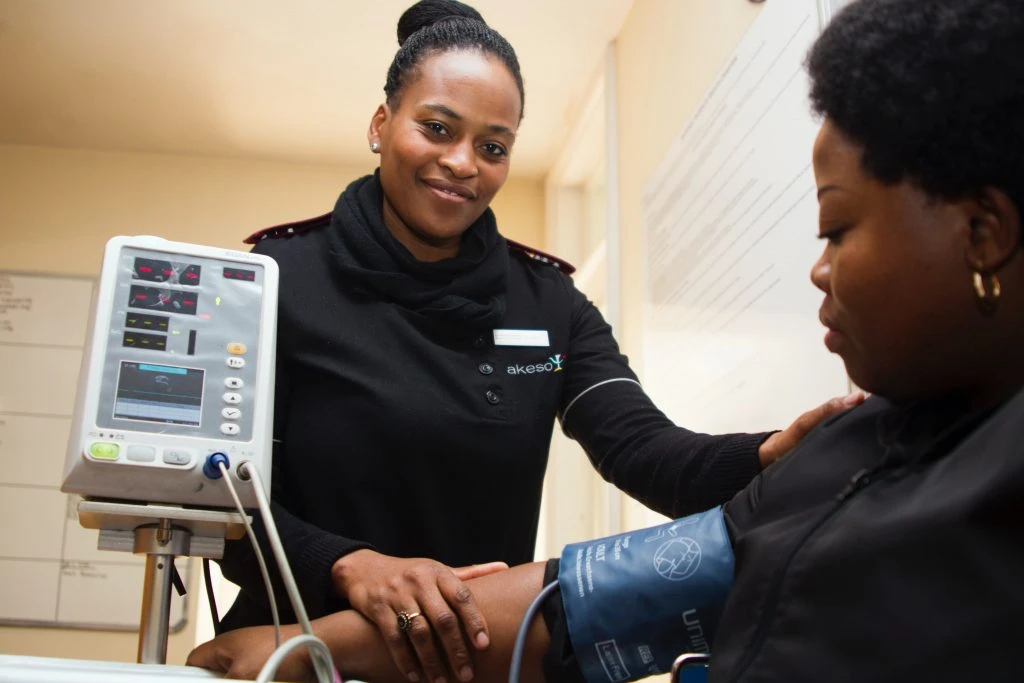
Program Specifics Include:
- Training and employment of over 300 residents for immediately available contact tracing related positions, with a focus on helping residents get on long-term career paths.
- Majority of positions are contact tracers, but the project also employs a care coordination team of about 40, which connects residents to needed social services, as well as operations support staff, supervisors, directors, managers, and career navigators to support the temporary contact tracer positions.
- Positions pay from $35,000 and up to $80,000 for the highest-level positions, and each includes a stipend to cover health benefits. Most last for eight months.
The project team carefully crafted new rubrics for screening and rating candidates prior to opening the job portal in June. The purpose of the rubrics is to eliminate barriers and bias in the process, while increasing equity and access to disadvantaged populations. These include detailed directions for applicant pre-screening, resume review, group screening and breakout session rubrics, and a rubric for pre-recorded interviews.
Once resumes have been screened through the portal, those that receive middle scores in the rubric are invited to a group interview with behavioral questions, while those that are high-scoring receive a link to pre-record an introductory interview, which will later be reviewed by staff.
The emphasis of the selection criteria throughout the interview process is on customer service and the ability to display empathy, as well as any other transferrable skill sets. This process provides opportunity for those middle scores to still advance in the process, with some being referred to shortterm upskilling programs, rather than being immediately referred to other programs and services outside of the Baltimore Health Corps.
Once hired, individuals in contact tracer positions begin two weeks of in-person training, and then their work is conducted from a centralized office building location until they are comfortable and competent with the contact tracing platform, after which they may opt to work from home. New employees are provided with a laptop and cell phone.
The provision of equipment is an equity strategy to ensure that some of those most at risk in the pandemic have the tools they need to be employed. Positions also come with employee supports, provided through MOED, including career navigation, financial empowerment counseling, and free behavioral health and legal services.
For a select number of applicants (up to 100) who show potential but might not yet ready for the contact tracer positions, the initiative offers a four-week community health worker training to help strengthen their candidacy. Completers are recommended to employers for priority recruitment, which serves as yet another equity strategy for upskilling local residents.
Key Partnerships:
The Baltimore Health Corps initiative is driven by critical partnerships. Key partners and their roles include:
- Mayor’s Office of Employment Development is the primary workforce agency, providing planning and staff for the recruitment and screening structure, career navigation, and connection to behavioral health support and legal services (offered through with Catholic Charities and Maryland Volunteer Lawyers Services).
- The Baltimore Civic Fund serves as the fiscal sponsor and provides assistance with fundraising and funding consolidation that supports streamlined relationships between funders and the city.
- Baltimore Corps conducts recruitment, providing the application website and the recruitment structure.
- Mayor’s Office of Performance and Innovation provides strategic and project management support.
- Jhpiego provides operational support to the Health Department, along with acting as a training partner for contact tracers and providing structure for performance monitoring.
- The University of Maryland School of Public Health is evaluating the program and will conduct a process study and summative evaluation.
- They are working on final outcome measures and supporting the team by providing a summary of performance metrics.
- The Baltimore Innovation Team (i-team) is supported by Bloomberg Philanthropies which awards cities multi-year grants to create highly skilled in-house teams that are dedicated to solving big problems in new ways — from reducing violent crime to revitalizing neighborhoods to strengthening the growth of small businesses.
The full list of partners and funders for this project include:
- Abell Foundation
- Annie E. Casey Foundation
- Baltimore City Health Department
- Baltimore Community Foundation
- Baltimore Ravens
- Bank of America
- Jacob & Hilda Blaustein Foundation
- Bloomberg Philanthropies
- BGE
- CareFirst
- France-Merrick Foundation
- Goldseker Foundation
- BACH (Baltimore Alliance for Careers in Health)
- Baltimore City Health Department
- Baltimore Civic Fund
- Baltimore Corps
- Catholic Charities of Baltimore
- HealthCare Access Maryland
- Jhpiego
- Maryland Volunteer Lawyers Service
- Mayor’s Office of Employment Development
- Mayor’s Office of Performance and Innovation
- Univ. of Maryland School of Public Health
Funding:
The total cost of the initiative is $12.44 million. This public-private partnership was mobilized by a $3 million commitment from The Rockefeller Foundation through its Equity & Economic Opportunity and Health teams. The City of Baltimore has made a $4.5 million commitment to support this initiative, tapping into its CARES Act Funds.
Additional private funders and local institutions have contributed more than $3.6 million in support and include the Annie E. Casey Foundation, Bloomberg Philanthropies, CareFirst BlueCross BlueShield (CareFirst), the France-Merrick Foundation, the Goldseker Foundation, OSI — Baltimore, the PepsiCo Foundation, the Rauch Foundation, the Stulman Foundation, and the T. Rowe Price Foundation. The city will continue to raise the remaining $1.3 million as the project moves forward.
Key Challenges:
Rapid partnership building
MOED and the Health Department had not previously worked this closely before on a combined effort at this scale. The entire initiative was built on leveraging virtual tools such as Zoom and Webex, from remotely coordinating partnership alignment and communication to recruitment efforts.
Prior to the pandemic, the Health Department had not previously relied on the workforce system for hiring needs, and did report having struggled at various times with recruitment and identifying applicants who meet the needs of a specific position but had not aligned themselves with the workforce system.
Through this new program, the Health Department expressed their satisfaction with the candidates that have been onboarded and working for a few weeks now. Baltimore Corps’ work to identify candidates who would be successful in this environment has been pivotal to their success.
The Health Department would recommend to other similar departments that are uneasy at taking on this challenge that it really has been an incredible experience, they are very happy and pleased with the results thus far and are looking forward to continuing the relationship.
Communicating vision to existing program staff
Developing processes for a large recruitment and placement initiative while not greatly expanding staff numbers (FTEs) could have been daunting to existing staff. Leadership developed a clear plan for weekly recruitment process flow and spoke directly with team members about the importance of the mission and value to the community. As a result of sharing the broader community vision, they were able to engender a sense of shared ownership and buy-in from staff as they launched the program.
Aligning communication strategy
Aligning a large multi-partner communication plan can be challenging in the best of times. At the outset, the Public Information Officers for each organization came together to engage their preexisting Joint Information Center (JIC) and worked to align their communication efforts. It had existed prior to the project; and, it was effectively leveraged in a virtual environment to coordinate the rapid building of this effort.
The Health Department took a lead role, along with MOED and Jhpiego, to get the word out to partners, and to the public through public virtual town halls, and at all relevant events held throughout Baltimore City. Additionally, they employed the use of multiple social media outlets, such as Twitter, Facebook, and Instagram. Partners met weekly, and shared information frequently across major program components, and continue to check in regularly as needed.
Summary of Project Impact
The team has received 4,500 applications since the program launched on June 4, 2020. As of November 6, over 200 applicants have accepted offers to join the Health Corps, and nearly 175 have already started their temporary positions with HCAM and the Health Department. To serve these staff, the Mayor’s Office of Employment Development hired five career navigators and placed approximately 100 participants into community health worker (CHW) training through the Baltimore Alliance for Careers in Healthcare.
The program team has contracted with University of Maryland School of Public Health to act as external evaluators. They will track standard workforce metrics as required by their grants but are looking to move beyond the traditional measures. They are also evaluating the public health contracting side of the project, as well as care coordination. The team will also conduct a post-intervention analysis to determine if the Health Corps program led participants to long-term employment within a health care career pathway.
How To Adapt this Approach:
Cost and Time Commitments:
From initial award to program launch, this program took six weeks. The rapid pace was driven by high COVID-19 case volume in the late spring and summer and a recognition of immediate need. The time and resources required to implement this model will depend on a variety of factors including:
- Availability and flexibility of funding streams
- Flexibility of existing team to work overtime and adaptability to shifting priorities
- Existing relationships and coordination with partners
- Community support and outreach strategies

Do:
- Do borrow from other models and adapt to local context.
The team leveraged the Massachusetts Partners in Health model to develop their contact tracing hiring strategy to allow for an explicit focus on rapid re-employment of the unemployed. They could have focused on quickly hiring the highest level of education possible, but their local commitment to employing dislocated workers with an equity lens required different strategies. The team believes the Baltimore Model is a promising and adaptive approach for other cities looking to expand their contact tracing capacity while addressing their jurisdiction’s economic and social needs. - Do engage employers throughout the process.
Because of the focus on upskilling participants and putting them on the road to clear career pathways in health, the team made the employer partners a part of the entire process — from weekly meetings to keeping them informed of participants’ training status. They were, of course, a key partner to the initiative, but their full engagement helped to drive the success of the recruitment process, and, in this way, demonstrated the key benefits of employer alignment. The employers’ public health expertise informed the program design and ensured that participants will come out of the program with the skills needed to go into full-time employment within an industry career pathway. - Do begin with a diverse and connected project management team.
The core team at Baltimore City included workforce experts, epidemiologists, community health work practitioners, and managers across each of the program objectives. Through these diverse viewpoints and early, open dialogue about program aims, the team was able to align its workforce and public health aims towards creating the most effective program possible. The team began by developing a solid operational framework that leveraged existing partnership organizations to support rapid implementation. The larger core project team across partners included leaders from all of the aligned organizations, totaling between 45-55 members.
Don’t:
- Don’t rely solely on traditional funding strategies.
Alignment of private funds and CARES Act funds, with a small portion of dislocated worker funds, provided the program team the flexibility to move ahead with recruitment and hiring for positions quickly to respond to urgent demand. Flexible funds also allowed Baltimore to contract for legal and mental health service supports quickly, and to support CHW training. - Don’t rely on traditional hiring strategies.
The Health Department partnered with the workforce team to craft job postings with no education requirements, which opened the process to a wide swath of the community. They also expedited their hiring process by working closely with Baltimore Corps and Jhpiego, employing the use of their existing online platform for screening candidates, and by developing a clear rubric and comprehensive plan for interviewing, training, and hiring.
Case Study #2
Train for Jobs SA, San Antonio, TX
- Training stipend of $15/hr
- Up to $450 per week
- Up to 10,000 residents by September 2021
- Anticipate 80% receiving wraparound support
In May 2020, Workforce Solutions Alamo (WSA), in partnership with the City of San Antonio and Bexar County, established Train for Jobs SA, a training program designed to quickly upskill dislocated individuals for high-growth industries and occupations.
In addition to free training, participants also receive weekly stipends and significant wraparound services to support successful completion of the program and then placement into a job. The program was made possible through the commitment of the City of San Antonio and Bexar County officials who prioritized workforce development as their leading strategy to guide the city into and through recovery from the pandemic.
The overall goal of the program is to provide economic stability for those who are displaced as well as ensure the talent needed to support local industry is available as businesses begin to recover. Train for Jobs SA aims to serve up to 10,000 San Antonio and Bexar County residents by September 2021.
Eligible participants enroll via phone, and once in the program, complete a skills and career assessment. Participants may then be enrolled in high school equivalency preparation, or short-term, long-term or on-the-job training, all of which are aligned to in demand occupations in the city’s target industries and growth occupations. There are a myriad of training courses available, both on and off of their Eligible Training Provider List (ETPL).
Qualified participants are eligible to receive stipends of $15/hour (for between a minimum of 6 hours and a maximum of 30 hours per week) for actual time spent in an approved training program, up to a maximum of $450 stipend per week. The stipend is made available for the full length of the training, with a focus on participants attaining new skills or credentials and keeping them engaged after the training to advance on a career pathway.
Train for Jobs SA is also a key driver supporting the City of San Antonio’s long-term goal of decreasing economic segregation. The program developed and uses an equity matrix questionnaire to identify participants in specific areas who are more at risk and prioritize them for enrollment and additional services.
Up to 80% of program participants are anticipated to receive comprehensive wraparound support such as case management, career navigation, and connection to other Workforce Innovation and Opportunity Act (WIOA)-funded services.
Key Partnerships:
Key partners for this project include:
Funding:
Funding was awarded to the Train for Jobs SA program in the amount of $12 million, with $8 million provided by the City of San Antonio General Fund and $4 million in Coronavirus Relief funding. Although they have received significant disaster grants, this program is separate and fully funded by city and county dollars. Co-enrollment and alignment with WIOA-funded programs is encouraged where appropriate.
Key Challenges:
Shifting to virtual delivery
Train for Jobs SA is working to improve virtual onboarding and orientation for participants. The project team is piloting online open sessions for orientations and the development of a video tutorial on how to sign up for services, to accompany the registration site.
Partner referrals and participant awareness
WSA noted that building system and public awareness is an ongoing challenge with any new program, yet it is critical to support referrals into the program. To address this challenge, the WSA team has launched a multi-modal messaging effort, including social media outlets such as Facebook, Twitter, Instagram, and numerous websites, to increase overall public awareness as well as reach specific populations targeted by the program.
Summary of Project Impact
With the start of the program in mid-August 2020, and active participant recruitment beginning in September, intake is active and ongoing. The team has developed a set of goals and measures for the project that include by September 2021 an anticipated: 4,000 assessed, 1,750 receiving case management services, 1,400 receiving short-term training, 100 receiving long-term training, 1,500 receiving stipends, and 1,000 placed in on-the-job training and employment. In the first five weeks of the program, 78 participants were placed in shortterm training, and 21 in long-term training.
Adapt This Approach:
Cost and Time Commitments:
With strong support from the Mayor’s office, funding was awarded during the summer and the program began in mid-August. In alignment with citywide equity goals, and more flexible funding streams, they were able to stand up a new, large program in a matter of weeks, and the program launched at the beginning of September. The time and resources needed to implement this model will depend on a variety of factors including:
- Flexibility of funding streams
- Buy-in and adaptability of partners
- Ability to borrow from existing tools and structures
- Availability of staff

Do:
- Do start — and proceed — with good data.
Prior to COVID, WSA determined high-growth occupations and identified the target industries that aligned with economic development goals for the region. Although WSA is operating under the assumption that many industries will return to previous employment levels post-COVID, they are also using real-time labor market information and job postings (such as Burning Glass and Help Wanted Online data) to monitor monthly shifts and pivot their training investments accordingly. - Do identify training providers upfront.
Provide as many options as possible by broadening the training provider pool and expanding the ETPL. By expanding the list of programs to include short-term as well as long-term, increasing the variety of training to all of the regional industries in demand, and increasing flexibility in training schedules, the program can become relevant for a broader array of participants. Training providers are a critical part of the planning process and can support workforce staff in identifying training gaps more quickly. - Do focus on program awareness.
Focus just as much on partner and staff awareness as participant awareness in your outreach campaign. Intentionally messaging the availability and value of services provided and quickly establishing an efficient process to drive program referrals will shorten the time frame between program design and participant enrollment. - Do focus on building trust between local elected officials and the local workforce board.
A key to success of this project has been the positioning of the local workforce development board (LWDB) as a natural leader in the region. The LWDB is seen by local elected officials (LEOs) as a trusted entity with the ability to analyze unemployment data as well as real-time data to help officials better assess the current situation and those most impacted by the pandemic. - Do incorporate strategies to reach equity goals.
The City of San Antonio uses an equity lens to prioritize investments and policy decisions. As previously noted, Train for Jobs SA uses an equity matrix to target key populations for recruitment and provides extensive support and wraparound services to drive successful program outcomes.
Don’t:
- Don’t rely solely on traditional funding strategies. A key to standing up the program in short order has been the ability to identify flexible funding streams that allow financial resources to be implemented quickly and in an innovative manner. The board worked directly with the Mayor’s office and other local city leadership to make general fund dollars available to support this program.
Resources:
- Train for Jobs SA informational site
- Participant site
- Workforce Solutions Alamo site
- San Antonio equity maps
- San Antonio, TX press release – $2 Million Dislocated Worker Upskilling Grant
- San Antonio, TX press release – $450 Stipend for Retraining
Learn more about the Workforce Tactical Guide
COVID-19 Economic Response and Recovery
Create a Coordinated Business Support System with Inclusive Outreach and Navigation
Action:
Lead the way in aligning small business services into a more unified, client-centered, data-driven business support system with a focus on MWBEs and LMI small businesses. The system should have a consolidated point of entry for small businesses support to triage, navigate, and refer entrepreneurs to the city’s broader business support network.
Why:
A more coordinated business support system will result in an improved client experience, better services, stronger providers, and clearer reporting on outcomes and impact.
Coordinated outreach, navigation, and referral to technical assistance providers will deepen the reach of programs, improve outcomes, and be particularly impactful for MWBE and LMI small businesses, which are often not able to access government small business programming.
Case Study #1
Inclusive Business Resource Network (IBRN) – Portland, OR
Prosper Portland, the Portland economic development agency, is focused on creating and improving systems that serve entrepreneurs, particularly for women and people of color. Through research and outreach, Prosper Portland recognized that women and minority entrepreneurs need to:
- Be in a community with other entrepreneurs who look like them
- Have access to mentors who share similar experiences
- Have access to a coordinated network of support providers
In January 2016, Prosper Portland launched the IBRN, a citywide program that supports a business from startup through growth, ensuring that technical assistance leads to wealth creation for underrepresented entrepreneurs.
The IBRN comprises of 20 organizations, which offer three levels of service:
- Light-touch (5–10 hours a year) such as the PPP loan walk-through, where a client can receive assistance with specific questions while applying for loans, as well as help accessing business services through culturally specific business navigators or geographically based business advisors
- Long-term (30+ hours a year) such as 1:1 technical assistance, peer cohort classes, and growth plan coaching
- Specialized services driven by the business’s need, such as legal support, credit coaching, marketing, and accounting programs
Prosper Portland serves as IBRN’s funder and convener. The network meets monthly to collaborate on client needs, share information, conduct trainings and work in topic-specific committees on program design iteration. The goal is to grow a community of thought leaders and business advisors who specialize in culturally specific business support.
The IBRN’s support providers use a standardized badging system to track long-term client progress. Badges reflect stages of business growth: Strong & Stable, Growth, Scale and Launch. Each badge has 9–12 different milestones, with the completion of four milestones required to earn each badge. Outcome data is reported annually in an IBRN Progress Report.
In 2018–19, the network:
- Served 1,043 entrepreneurs — 72% were people of color and 58% were women.
- Supported 100+ profitable businesses, which retained 640 jobs, and created 504 jobs.
89% of supported business owners who responded to the annual program survey felt their business advisor respected their culture/made them feel welcome, 73% said it was easy to access services from providers, and 57% said they have seen sales increase as a result of the support.
Case Study #2
Technical Assistance Partnership – Baltimore, MD
In April 2020, Baltimore Development Corporation (BDC) and the Baltimore Small Business Support Fund (BSBSF) created the BDC-BSBSF Technical Assistance Partnership to help small businesses struggling to access capital due to COVID-19 by connecting them to a network of technical assistance providers.
The partnership consists of 19 local organizations — 8 are small business technical assistance providers and 11 are nonprofits and community organizations that bring connections to the community and provide targeted outreach.
The BDC serves as the partnership’s central coordinator and is responsible for communications among the partners, directing technical assistance requests to appropriate organizations, disseminating updated information about new financial assistance opportunities, developing partnerships with lenders and other support organizations, and capturing and sharing data related to the partnership’s efforts.
The BSBSF provides grant funding, approximately $125,000 per year, to each of the nonprofit technical assistance providers to increase their capacity and support for entrepreneurs of color looking to access capital. Community outreach organizations receive approximately $10,000 per year to execute targeted community outreach.
The partnership has prioritized outreach to MBEs, assessing whether programs were appropriate for them, identifying appropriate lenders, assisting business with online applications and providing language assistance.
The BSBSF is supported by a number of philanthropic foundations and financial institutions.
The BDC-BSBSF Technical Assistance Partnership resulted in a singular, coordinated small business support ecosystem that brings Baltimore’s various small business support organizations together, minimizes the duplication of efforts, and streamlines delivery of and referrals to technical assistance — improving the experience for small business clients.
While it was created to respond to COVID-19, the BDC and BSBSF are in discussions to continue the partnership, with a focus on helping MWBEs access long-term recovery and growth capital.
As of June 30, the partnership had engaged over 1,000 small businesses. Of those small businesses, 48% are minority-owned and 32% are Black-owned. In addition, 56% are women-owned.
Most of the businesses assisted by the partnership are microenterprises, 40% are sole-proprietors or self-employed, 37% have between 2–5 employees, and 23% have more than 5 employees.
An initial business survey showed that out of 24 businesses who received assistance in applying for the Paycheck Protection Program (PPP) loans, 83% were approved. All were minority-owned small businesses.

How to Adapt This Approach:
- Assess the effectiveness of the current small business support system
– Reach out to a diverse set of small businesses, business groups and local stakeholders through one-on-one interviews, focus groups and surveys. Be sure to engage communities of color and LMI businesses to understand the specific needs of their communities
– Evaluate reporting and outcome data from business support providers and any City run programs. Review the profile of which business (e.g., sector, size, business type, ownership profile, neighborhoods, etc.) are receiving the most and least amount of services and how effective those services have been - Build a coalition of business support providers (e.g., nonprofits, academic, other government agencies, etc.) to review findings of the assessment, agree on shared goals for aligning the system and develop a project plan to advance these goals
- Develop a comprehensive map of the small business support services available in the city.
– Take a client centric approach to identify missing services, determine gaps in the system where entrepreneurs get stuck or fall through the cracks, and assess which services are most and least effective
– Consider language access, cultural competency, outreach/proximity to high need communities and other factors when evaluating existing services - Working through the coalition of business support providers, develop an implementation plan with specific actions to create a more unified system. These actions could include:
– Establish one support provider or City agency to serve as the primary point of entry for small business services— triaging, navigating, and case managing the small business through the business support system
– Draw on the comprehensive service map to create a consolidated business portal designed for small business clients to quickly understand, navigate and access business services
– Agree to a uniform set of KPIs. Develop a unified data system/client relationship management (CRM) tool to track a business clients experience across the business support system and measure impact
– Create a “community of practice” with regular meetings so providers can coordinate on cases, share best practices/challenges, conduct trainings and coordinate on the delivery of the implementation plan
– Develop new programming to address gaps in services. Cities could fund these services directly or advocate for philanthropic, corporate or other governmental funding sources.
– If the City is contracting for business support services with nonprofit providers, include as part of the contract requirements to coordinate on the above elements - Partner with merchant associations, local/ethnic chambers, and other community groups, which are trusted partners in the communities, to drive outreach, promote and connect harder-to-reach businesses to business support
- Track and publish KPIs on a regular basis. Include aggregated demographic and neighborhood data on businesses being served, services provided, outcomes, etc. across the entire system. (See KPIs section)
Learn more about the Tactical Guide
Action:
Work with local communities to develop marketing campaigns which will give residents and nearby travelers reasons to explore your destination’s “off the beaten track neighborhoods”.
Why:
Travelers’ inclinations and behaviors have been transformed because of the fear of getting infected, trapped, or quarantined. As a result, travelers are looking for opportunities to travel to destinations which are closer to home, familiar, predictable and low risk.
Background:
Travel restrictions to and from countries combined with insecurity regarding crowded airport terminals and flights mean that domestic tourism is likely to recover much more quickly, and local holiday options and weekend staycations are increasing in popularity.
Even before the pandemic, the U.S. domestic tourism market was worth nearly U.S.$ 1 trillion. Since 2020, many destinations have focused on growing domestic tourism, including programs to encourage residents to explore their own cities. These include initiatives focused on marketing and promotion, as well as financial incentives.
Examples:
- As part of its All In NYC campaign, New York City’s NYC&Co created weekend neighborhood guides, such as Exploring Black-Owned Harlem, and a Tour Your Own City program, to encourage residents to explore different parts of the city.
- London created “Because I’m a Londoner” citywide campaign to inspire a recovery in consumer spending by encouraging residents to responsibly rediscover the capital and support local businesses, organisations, areas and places. It also created the London Alliance, a community of 500+ businesses, which were provided with free assets to use as part of the campaign. The campaign increased consumer confidence by 5% and led to a 43% uplift in frequency of going out.
- Toronto, Canada created a program called Bag of Toronto, which encouraged residents to purchase goods from different city neighborhoods. Cleveland created a similar program, called Cleveland in a Box.
- Visit Houston marketed coupons and deals on its Houston Experience Marketplace to local residents. The marketplace is delivered in partnership with Bandwango’s technology platform, and generates income for the DMO.
- Geneva, Switzerland gave overnight visitors gift cards preloaded with 100CHF (~$110) which could be used at a range of hotels, restaurants, cafes, bars and on activities around the city.
- Explore France partnered with cities to create a campaign #CetÉtéJeVisiteLaFrance, to inspire its citizens to explore 21 city-regions across the country.
- Little Rock convention bureau partnered with the local historic association to create a series of audio guides for walking and driving tours. The tours have been enjoyed by students doing remote learning and will be marketed for visitors to come.

Guidance:
Bloomberg Associates has created a “how to” guide to create a neighborhood tourism campaign, which can be found at Appendix 2.
We have also created a “how to” guide to segment your target audience, which can also be found in the Appendix.
We are not, therefore, able to share a case study of emerging good practice by a DMO at this time.
Learn more about the Tactical Guide
Action:
Invest in and partner with local CDCs, technical assistance providers, district management associations, merchant associations, and other nonprofit partners, which support MWBEs and businesses in LMI communities. Examples include sponsoring fellows or secondees, building philanthropic support, and providing small grants for board development or succession planning.
Why:
In this way, you are extending their ability to do local outreach, leveraging additional funding sources, and building neighborhood capacity to deliver local programming.
Case Study
Neighborhood 360° – New York, NY
The New York City Department of Small Business Services (SBS) created the Neighborhood 360° program to support projects that revitalize commercial districts and build capacity amongst community-based organizations who provide assistance to neighborhood businesses.
The program is funded from City tax levy funding and provides multi-year grants, up to $500,000 annually, to local nonprofits to deliver projects based on needs identified in a Commercial District Needs Assessment (CDNA) report. The nonprofit is required to use part of the funding to hire a full-time program manager.
A CDNA report analyzes a commercial corridor’s storefront and retail mix, consumer profile, streetscape conditions that affect the shopping experience, and any unique characteristics. The analysis includes data obtained from door-to-door merchant surveys and consumer and shopper surveys. It is intended to be a roadmap for community-based partners to use to prioritize needs and interventions, as well as a tool to support fundraising efforts.
SBS also funds Neighborhood 360° Fellows for community-based organizations. These are paid SBS employees placed at community-based partners who work full time for 10 months to oversee commercial revitalization projects. Fellows also help the organizations expand their outreach to local businesses and to connect to City resources.
To date, the program has invested over $11 million in direct support to community-based organizations in 20 neighborhoods. Projects have included cleanliness and beautification, business support and retention (including free legal and accounting support), placemaking and district marketing, merchant organizing, and coordination of local program partners. Support has been provided to business improvement districts, merchant associations, local development corporations, and chambers of commerce.

How to Adapt This Approach:
- Identify possible municipal or Federal (e.g., CDBG dollars) funding to invest in a nonprofit capacity building program
- Develop goals and grant eligibility criteria
- Determine the staff resources and expertise required to administer the funding and provide technical assistance and program management support to the recipients
- Reach out to nonprofits with local trust and cultural competency, as well as organizational capacity, to support MWBEs
- Use a tool like TCC Group’s Core Capacity Assessment Tool to assess a nonprofit’s ability to achieve its mission
- Facilitate best practice sharing and group technical assistance among grantees
– Develop cohort learning opportunities including workshops, corridor tours, subject matter trainings, and convenings
– Create and moderate a platform for grantees to communicate and share successes outside of formal convenings (e.g., Google Group, Slack, Facebook group, etc.)
– Foster connections with other City agency resources; request staff from other departments (e.g., parks, sanitation, transportation, planning, etc.) to speak to community-based partners about their services - Design an outreach plan to market fellowship opportunities to residents in priority neighborhoods; post information on local neighborhood anchor websites and brick and mortar locations and with local universities’ alumni networks
- Establish a tracking system to collect data from partners to measure program impact
